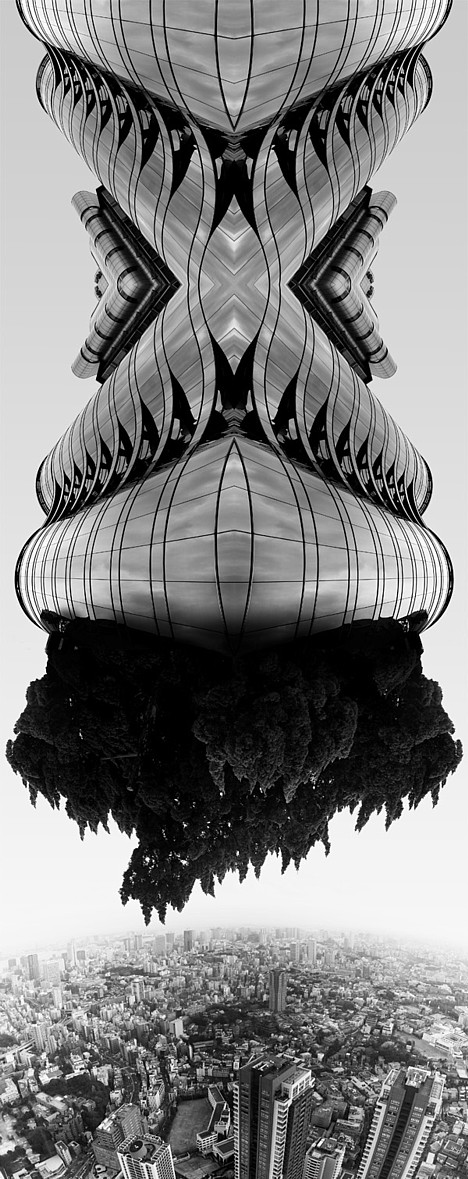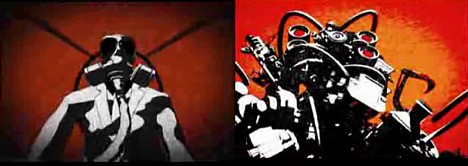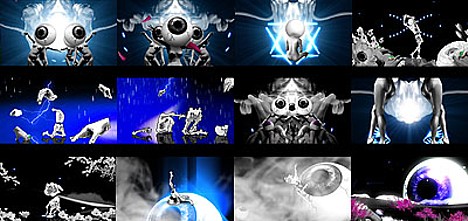
From Frederic Gautron's Urbano-vegetal series of digital photomontages.
[Link: Made in Tokyo]

The promo video for "ILL MACHINE (x ULTRA BRAiN)," a track off the recently released Nu Riot CD by Wagdug Futuristic Unity (a project involving Kyono of the Mad Capsule Markets), is set in a world 50 years hence (according to Kyono's blog), where heavily armed gas-masked clones battle giant machines that assemble themselves from trash and set out to cleanse the planet by blasting everything to smithereens. Directed by CG artist Satoshi Kuroda.
[Link: ILL MACHINE (x ULTRA BRAiN)]
The January 8 issue of DIME magazine takes a peek at some of the events, products and developments expected to have an impact on Japan in 2008. Here is a small taste of the many items mentioned in their preview (in no particular order).
Apple, Disney tap into Japanese phone market
 Of the countless new electronic products to be unveiled in Japan this year, few are likely to generate the amount of buzz that will accompany the Japanese launch of the yet-to-be-announced 3G iPhone. For the time being, would-be iPhone fans are holding their collective breath for all the gory details and specs, which may or may not come out at MacWorld 2008 (January 14-18).
Of the countless new electronic products to be unveiled in Japan this year, few are likely to generate the amount of buzz that will accompany the Japanese launch of the yet-to-be-announced 3G iPhone. For the time being, would-be iPhone fans are holding their collective breath for all the gory details and specs, which may or may not come out at MacWorld 2008 (January 14-18).
Disney is also expected to make a splash with its entry into the mobile phone service market in spring. Working with Softbank, Disney will deliver mobile content to subscribers and help to develop new handsets -- which means we can probably look forward to an explosion of character-themed phones as the year progresses. (On a separate but related note, Tokyo Disneyland will be holding a year-long celebration to mark its 25th anniversary. Festivities will include the grand opening of the 705-room Victorian-style Tokyo Disneyland Hotel this summer.)
Electronic turf wars
With a little luck, the Blu-ray vs. HD DVD format war should finally come to a head this year in Japan. Tsutaya, Japan's largest movie rental company, is weighing the pros and cons of each format and preparing to decide which one to put on its store shelves. Some analysts argue that Tsutaya's choice will play a decisive role in determining which camp ultimately prevails.
In a different type of turf battle, competition between major electronics retailers is intensifying as Yamada Denki (LABI) continues to beef up its presence around the major train stations in central Tokyo. In recent months, Yamada has opened large-scale outlets in Ikebukuro, Akihabara, Shimbashi and Oimachi, and rumors suggest more are to come this year in Shibuya and Shinjuku. Good news for shoppers.
Dubbing 10
While the Olympics are expected to fuel demand for home entertainment systems, there is another development that promises to inject a little excitement into the DVD recorder market. "Dubbing 10," a new digital content protection system set to launch this year, gives Japanese consumers more freedom to copy digital broadcasts (compared to existing restrictions). As the name suggests, the new system allows digital broadcasts to be copied up to nine times and transferred to another playback device once. Although the Dubbing 10 system does not allow copies to be duplicated, it is still good news for consumers who, under the current digital content protection system (CPRM), are only allowed one opportunity to copy or transfer broadcasts that have been flagged as "copy once." Dubbing 10-compatible recorders are set to hit shelves soon, and Toshiba and Panasonic have announced they will be offering Dubbing 10 software upgrades for existing "copy once" recorders.
The next "B-sport" sweetheart?

When it comes to nubile young female athlete idols, the letter "B" stands for beach volleyball and badminton. In 2007, beach volleyballer Miwa Asao raised eyebrows when she released a gravure DVD and posed for sexy Sabra magazine, while badminton doubles team Kumiko Ogura and Reiko Shiota (together known as "Ogushio") were the subject of a popular photobook. In 2008, "B" might also come to signify bowling, as 17-year-old bowling idol (or bowdol, as some like to say) Rina Asada rises to stardom. Last year, Asada began appearing regularly on Nihon TV's "P-League" late-night bowling program, which features amateurs and professionals competing in tournaments. She also won the women's national high school bowling championship in July and has been selected as a member of Japan's national team. Some say her popularity could help spark a bowling craze among the nation's youth.
Government vs. metabolic syndrome
In April 2008, the Ministry of Health, Labour and Welfare will begin implementing new guidelines to combat metabolic syndrome and reduce the burden of associated medical costs. In addition to calling for new metabolic syndrome-specific health checks for 40- to 74-year-olds enrolled in public insurance programs, the guidelines will include diet, exercise and lifestyle recommendations for reducing the risk of developing the syndrome.
On top of boosting health awareness, the guidelines are expected to spur growth in the emerging market for metabolic syndrome-related goods and services, which is estimated at about 500 billion yen ($4.5 billion) in 2008. Fat-fighting food and drinks, such as Kao's popular Healthia teas and Suntory's oolong tea (kuro oolong cha), are expected to remain big-sellers, while new health-related devices, such as Omron Healthcare's pedometer that counts "aerobic steps" in addition to daily steps, are expected to appear.
 This year will also see the rise of a new type of business in which medical institutions team up with fitness gyms to help customers fight metabolic syndrome. One such example is the Medical Fitness OreoS facility that opened in Okutama (Tokyo) in September 2007. Established through a partnership between the Seijo drug store chain and a medical corporation, the fitness center provides individual customers with health advice and exercise programs based on the results of thorough medical examinations. The company is looking to open new facilities in 2008.
This year will also see the rise of a new type of business in which medical institutions team up with fitness gyms to help customers fight metabolic syndrome. One such example is the Medical Fitness OreoS facility that opened in Okutama (Tokyo) in September 2007. Established through a partnership between the Seijo drug store chain and a medical corporation, the fitness center provides individual customers with health advice and exercise programs based on the results of thorough medical examinations. The company is looking to open new facilities in 2008.
Another such facility is suUhaa Atami, an upscale medical resort scheduled to open in the city of Atami (Shizuoka prefecture) in the fall of 2008. With a hotel, health clinic, gym and spa, suUhaa Atami aims to provide a unique short-term resort experience to Tokyo residents interested in fighting metabolic syndrome. The large-scale facility is also expected to stimulate the local economy.
Trouble in smokers paradise
Cigarette smokers in Japan will feel the pinch in 2008 as the country continues its crawl toward a smoke-free public environment. New rules that ban smoking in the vast majority of Tokyo taxis will take full effect on January 7. According to the two major industry groups that oversee 52,000 taxis in Tokyo (95% of the total), drivers are being instructed to accommodate the demands of chain-smoking passengers by pulling over and letting them out for nicotine breaks as needed. Drivers are also being provided with portable ashtrays to give to passengers while they smoke outside.
 Smokers under the legal age of 20 will also feel the pinch as electronic age verification systems come to Japan's vast network of cigarette vending machines. In February, the Tobacco Institute of Japan will begin issuing age verification smart cards, called "taspo," which will need to be scanned at vending machines each time a purchase is made. Age-checking machines will start appearing in March, and the system is scheduled to be fully deployed nationwide by July. The taspo cards will also be equipped with an electronic money function, called "pidel," which will enable customers to make purchases with a simple swipe of the card (the machines will also allow users to add pidel funds to their taspo cards). It should not be long before taspo-capable cellphones begin to appear.
Smokers under the legal age of 20 will also feel the pinch as electronic age verification systems come to Japan's vast network of cigarette vending machines. In February, the Tobacco Institute of Japan will begin issuing age verification smart cards, called "taspo," which will need to be scanned at vending machines each time a purchase is made. Age-checking machines will start appearing in March, and the system is scheduled to be fully deployed nationwide by July. The taspo cards will also be equipped with an electronic money function, called "pidel," which will enable customers to make purchases with a simple swipe of the card (the machines will also allow users to add pidel funds to their taspo cards). It should not be long before taspo-capable cellphones begin to appear.
Japan-Brazil exchange year

In April 1908, the Kasato-Maru set sail from the port of Kobe carrying a group of Japanese emigrants headed to Brazil. Most of the passengers ended up working in harsh conditions on coffee farms, but the voyage marked the first of many to follow as Japanese emigrants felt drawn to the opposite end of the earth in search of a better life. Now, a century later, Brazil is home to 1.5 million ethnic Japanese -- the largest population outside Japan. To commemorate the 100th anniversary of the first Kasato-Maru voyage and highlight the Japanese cultural legacy in Brazil, the nations have designated 2008 a Japan-Brazil exchange year. More than 100 special events ranging from music festivals to friendly soccer tournaments are scheduled in Japan this year.
[Source: DIME, Jan. 8, 2008 (print)]

T-shirt retailer Beams-T is handing out a free art-themed DVD magazine to customers in Japan. The DVD showcases the work of five artists from around the world, including this incredibly loony scrolling video-collage of found GIF animations put together by international man of mystery Subway Lung (a.k.a. Tokyo Windbag).
You can see the other DVD magazine videos on kurandofuruya's YouTube page (the light-based graffiti video by Kieph/Atsushi Sasaki is also recommended).
This 1998 news report shows urban climber Alain Robert (a.k.a. "Spiderman") scaling the exterior wall of a Tokyo skyscraper bare-handed. The video begins with Spiderman requesting official permission to climb a building. After being denied, he heads over to the 54-story Shinjuku Center Building, which stands 223 meters (732 feet) tall, and he quickly scurries up the side before anyone can stop him. When he reaches the roof about 38 minutes later, Spiderman is detained by police who, according to his website, roughed him up for 5 days until the French Embassy negotiated his release. Spiderman has scaled more than 70 giant structures around the world, many without the use of climbing equipment. [Video]

Omodaka's 21st-century disco version of Kokiriko Bushi -- an ancient folk song that Gokayama (Toyama prefecture) villagers used to perform for the local Shinto deities -- combines synthesized vocals with a Stevie Wonder-ish bassline and '80s video game chiptune sounds, and the wonderfully quirky and surreal video (animated by Teppei Maki) features a fragile skeleton dancer that shares the floor with lots of disembodied hands and floating eyeball-headed ladies. [Video]
Incidentally, the kokiriko is a type of percussion instrument made from old bamboo used in the roofs of traditional farmhouses. After being all but forgotten, Kokiriko Bushi was revived in the mid-20th century and has become one of Japan's most well-known folk songs.
Teppei Maki also directed the animation for DJ Kentaro's Tasogare Highway High...
...and he has worked on videos for Kaskade (Be Still), the Beat Crusaders (Your Song Is Good) and Fuuri (Nana Song), none of which appear to be available online.

For decades, dekochari have been the ride of choice for hardcore Japanese dekotora fans that are too young to drive. Modeled after Japan's celebrated art trucks, dekochari (deko means "decoration" and chari is slang for "bicycle") typically feature large front bumpers, ornate luggage racks, rear-mounted boxes that resemble truck trailers, colorful paint jobs, lots of chrome, and sophisticated electric light displays. This video pieces together random night scenes from Dekochari Yarou, a documentary that profiles a few dekochari enthusiasts and their custom rides. The soundtrack is "Ichiban-boshi Blues" (sung by Bunta Sugawara and Kinya Aikawa), the theme song from the Torakku Yarou movie series that sparked Japan's dekotora craze in the '70s.
+ Video
In 2003, Australian public broadcaster SBS aired a 6-part documentary series titled "Subsonics," which profiled experimental musicians from around the world. The show featured a number of artists from Japan, including Otomo Yoshihide, Masonna, Ai Yamamoto, Sachiko M, and others. Here are a few clips...
- Ai Yamamoto: Glimpse -- This segment features the abstract electronic melodies and digital animation of Ai Yamamoto, who says she started making videos to give the audience something to look at during her live performances. (From Subsonics, Episode 2.)
- No Input -- This clip looks at the work of Sachiko M and Toshimaru Nakamura, two prominent figures in the so-called onkyo ("reverberation of sound") movement, whose artists place more emphasis on sound texture than on musical structure. "No Input" is described as a form of music where the musicians play samplers, mixers and other electronic devices without any external audio sources -- the original sounds are created by plugging each device's output back into its own input to create a closed electronic feedback circuit. (From Subsonics, Episode 4.)
- Scanning of Modulations: Condition #4 -- The documentary ran several clips from "Scanning of Modulations," a collection of digital art videos by visual media designer Naohiro Ukawa. This video features the music of Kazunao Nagata. (From Subsonics, Episode 1.)
- Scanning of Modulations: Condition #1 -- More digital animation by Naohiro Ukawa, set to music by Hado-Ho. (From Subsonics, Episode 4.)
- The Many Moods of Otomo Yoshihide -- This clip focuses on Otomo Yoshihide, who, as an experimental musician, turntablist, guitarist and composer, has been one of the most adventurous and prolific artists of the underground Tokyo music scene since the '80s. (From Subsonics, Episode 6.)
- Masonna: God of Noise -- This segment profiles extreme noise musician and performance artist Masonna, whose intense live shows usually last under a minute and often end in injury. (From Subsonics, Episode 1.)
For clips on some of the other artists profiled, including Sun Ra, Sue Harding (who creates music from dot matrix printers), Jon the Dog (a mysterious Japanese singer/organist in a dog suit) and more, see the Subsonics videos uploaded by evilpaul (YouTube).